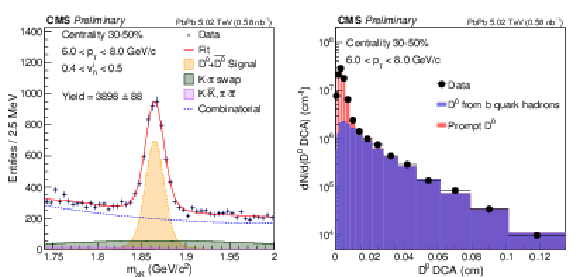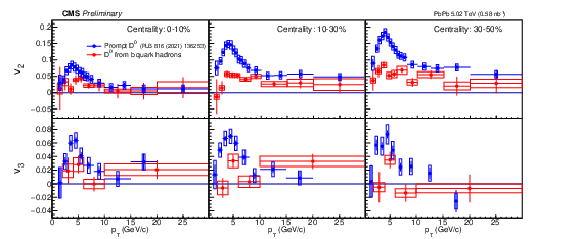

Compact Muon Solenoid
LHC, CERN
| CMS-PAS-HIN-21-003 | ||
| Azimuthal anisotropy of nonprompt D$^{0}$ mesons in PbPb collisions at ${\sqrt {\smash [b]{s_{_{\mathrm {NN}}}}}}= $ 5.02 TeV | ||
| CMS Collaboration | ||
| April 2022 | ||
| Abstract: The azimuthal anisotropy elliptic ($v_2$) and triangular ($v_3$) Fourier coefficients of D$^{0}$ mesons produced in B hadron decays are measured in PbPb collisions at ${\sqrt {\smash [b]{s_{_{\mathrm {NN}}}}}}= $ 5.02 TeV. Due to the larger bottom quark mass as compared to the charm quark mass, separate measurements of charm and bottom hadron azimuthal anisotropy can shed new light on understanding the mass dependence of the heavy quark and medium interaction. The results show lower magnitude of $v_2$ and $v_3$ and significantly weaker dependence on transverse momentum and centrality than those found for non-decay D$^{0}$ mesons. A non-zero $v_3$ coefficient of the D$^{0}$ mesons from B decay is observed. Obtained results are in qualitative agreement with theoretical predictions. | ||
|
Links:
CDS record (PDF) ;
CADI line (restricted) ;
These preliminary results are superseded in this paper, Submitted to PLB. The superseded preliminary plots can be found here. |
||
| Figures | |

png pdf |
Figure 1:
An example of the fit to the invariant mass spectrum (left panel) and an example of the template fit of the inclusive D$^{0}$ meson yields, extracted as a function of DCA, (right panel) are shown. |

png pdf |
Figure 1-a:
An example of the fit to the invariant mass spectrum (left panel) and an example of the template fit of the inclusive D$^{0}$ meson yields, extracted as a function of DCA, (right panel) are shown. |

png pdf |
Figure 1-b:
An example of the fit to the invariant mass spectrum (left panel) and an example of the template fit of the inclusive D$^{0}$ meson yields, extracted as a function of DCA, (right panel) are shown. |

png pdf |
Figure 2:
The elliptic, $v_2$, (top panel) and the triangular, $v_3$, (bottom panel) flow coefficient of nonprompt and prompt (from [14]) D$^{0}$ mesons as functions of $p_{\mathrm {T}}$ and in three bins of centrality. The bars and the boxes represent statistical and systematic uncertainties, respectively. |

png pdf |
Figure 3:
The elliptic, $v_2$, (top panel) and the triangular, $v_3$, (bottom panel) flow coefficients of nonprompt D$^{0}$ mesons as functions of transverse momentum and in three bins of centrality. The bars and the boxes represent statistical and systematic uncertainties, respectively. The colored bands stand for theoretical predictions [37,38,39,40,41,42,43]. |
| Summary |
| In summary, the elliptic ($v_2$) and triangular ($v_3$) flow harmonics of D$^{0}$ mesons that come from B hadron decay ($\mathrm{B} \rightarrow \mathrm{D}^{0}$) are measured in PbPb collisions at ${\sqrt {\smash [b]{s_{_{\mathrm {NN}}}}}}=$ 5.02 TeV. The $v_2$ results suggest a transverse momentum dependence and a slight increase for less central collisions. A non-zero $v_3$ coefficient is observed with very weak centrality dependence. This implies that $b$ quark collectivity is affected by event-by-event fluctuations. The magnitudes of the flow coefficients are significantly lower for $\mathrm{B} \rightarrow \mathrm{D}^{0}$ than was measured for non-decay D$^{0}$ mesons. This magnitude difference is more pronounced in the case of $v_2$. Various theoretical calculations are also presented, showing qualitative agreement with data. |
| References | ||||
| 1 | BRAHMS Collaboration | Quark pluon plasma an color glass condensate at RHIC? The perspective from the BRAHMS experiment | NP A 757 (2005) 1 | nucl-ex/0410020 |
| 2 | PHOBOS Collaboration | The PHOBOS perspective on discoveries at RHIC | NP A 757 (2005) 28 | nucl-ex/0410022 |
| 3 | STAR Collaboration | Experimental and theoretical challenges in the search for the quark gluon plasma: The STAR Collaboration's critical assessment of the evidence from RHIC collisions | NP A 757 (2005) 102 | nucl-ex/0501009 |
| 4 | PHENIX Collaboration | Formation of dense partonic matter in relativistic nucleus-nucleus collisions at RHIC: Experimental evaluation by the PHENIX collaboration | NP A 757 (2005) 184 | nucl-ex/0410003 |
| 5 | J.-Y. Ollitrault | Anisotropy as a signature of transverse collective flow | PRD 46 (1992) 229 | |
| 6 | U. Heinz and R. Snellings | Collective flow and viscosity in relativistic heavy-ion collisions | Ann. Rev. Nucl. Part. Sci. 63 (2013) 123 | 1301.2826 |
| 7 | C. Gale, S. Jeon, and B. Schenke | Hydrodynamic modeling of heavy-ion collisions | Int. J. Mod. Phys. A 28 (2013) 1340011 | 1301.5893 |
| 8 | B. Alver and G. Roland | Collision geometry fluctuations and triangular flow in heavy-ion collisions | PRC 81 (2010) 054905 | 1003.0194 |
| 9 | A. Beraudo et al. | Extraction of heavy-flavor transport coefficients in QCD matter | NP A 979 (2018) 21 | 1803.03824 |
| 10 | F. Prino and R. Rapp | Open heavy flavor in QCD matter and in nuclear collisions | JPG: Nucl. Part. Phys. 43 (2016) 093002 | 1603.00529 |
| 11 | M. Cacciari, P. Nason, and R. Vogt | QCD Predictions for Charm and Bottom Quark Production at RHIC | PRL 95 (2005) 122001 | hep-ph/0502203 |
| 12 | ALICE Collaboration | D-meson azimuthal anisotropy in mid-central Pb-Pb collisions at $ {\sqrt {\smash [b]{s_{_{\mathrm {NN}}}}}} = $ 5.02 TeV | PRL 120 (2018) 102301 | 1707.01005 |
| 13 | CMS Collaboration | Measurement of prompt D$^{0}$ meson azimuthal anisotropy in PbPb collisions at $ {\sqrt {\smash [b]{s_{_{\mathrm {NN}}}}}} = $ 5.02 TeV | PRL 120 (2018) 202301 | CMS-HIN-16-007 1708.03497 |
| 14 | CMS Collaboration | Measurement of prompt $ \mathrm{D}^0 $ and $ \overline{\mathrm{D}}^0 $ meson azimuthal asymmetry and search for strong electric fields in PbPb collisions at $ {\sqrt {\smash [b]{s_{_{\mathrm {NN}}}}}}= $ 5.02 TeV | PLB 816 (2020) 136253 | CMS-HIN-19-008 2009.12628 |
| 15 | ATLAS Collaboration | Measurement of azimuthal anisotropy of muons from charm and bottom hadrons in Pb+Pb collisions at $ {\sqrt {\smash [b]{s_{_{\mathrm {NN}}}}}} = $ 5.02 TeV with the ATLAS detector | PLB 807 (2020) 135595 | 2003.03565 |
| 16 | CMS Collaboration | Suppression and azimuthal anisotropy of prompt and nonprompt J/$ \psi $ production in PbPb collisions at $ \sqrt{(s_{_{NN}})} = $ 2.76 TeV | EPJC 77 (2017) 252 | CMS-HIN-14-005 1610.00613 |
| 17 | ALICE Collaboration | Elliptic flow of electrons from beauty-hadron decays in Pb-Pb collisions at $ {\sqrt {\smash [b]{s_{_{\mathrm {NN}}}}}} = $ 5.02 TeV | PRL 126 (2021) 162001 | 2005.11130 |
| 18 | Particle Data Group Collaboration | Review of particle physics | CPC 40 (2016) 100001 | |
| 19 | CMS Tracker Group Collaboration | The CMS phase-1 pixel detector upgrade | JINST 16 (2021) P02027 | 2012.14304 |
| 20 | CMS Collaboration | Track impact parameter resolution for the full pseudo rapidity coverage in the 2017 dataset with the CMS phase-1 pixel detector | CDS | |
| 21 | CMS Collaboration | The CMS experiment at the CERN LHC | JINST 03 (2008) S08004 | CMS-00-001 |
| 22 | CMS Collaboration | The CMS trigger system | JINST 12 (2017) P01020 | CMS-TRG-12-001 1609.02366 |
| 23 | CMS Collaboration | Charged-particle nuclear modification factors in PbPb and pPb collisions at $ {\sqrt {\smash [b]{s_{_{\mathrm {NN}}}}}} = $ 5.02 TeV | JHEP 04 (2017) 039 | CMS-HIN-15-015 1611.01664 |
| 24 | T. Sjostrand et al. | An introduction to PYTHIA 8.2 | CPC 191 (2015) 159 | 1410.3012 |
| 25 | CMS Collaboration | Extraction and validation of a new set of CMS PYTHIA 8 tunes from underlying-event measurements | EPJC 80 (2020) 4 | CMS-GEN-17-001 1903.12179 |
| 26 | D. J. Lange | The EvtGen particle decay simulation package | NIMA 462 (2001) 152 | |
| 27 | I. P. Lokhtin and A. M. Snigirev | A model of jet quenching in ultrarelativistic heavy ion collisions and high-$ {p_{\mathrm{T}}} $ hadron spectra at RHIC | EPJC 45 (2006) 211 | hep-ph/0506189 |
| 28 | GEANT4 Collaboration | GEANT4--a simulation toolkit | NIMA 506 (2003) 250 | |
| 29 | CMS Collaboration | Description and performance of track and primary-vertex reconstruction with the CMS tracker | JINST 9 (2014) P10009 | CMS-TRK-11-001 1405.6569 |
| 30 | Particle Data Group, M. Tanabashi et al. | Review of particle physics | PRD 98 (2018) 030001 | |
| 31 | H. Voss, A. Hocker, J. Stelzer, and F. Tegenfeldt | TMVA, the toolkit for multivariate data analysis with ROOT | in XIth International Workshop on Advanced Computing and Analysis Techniques in Physics Research (ACAT), p. 40 2007 [PoS(ACAT)040] | physics/0703039 |
| 32 | A. M. Poskanzer and S. A. Voloshin | Methods for analyzing anisotropic flow in relativistic nuclear collisions | PRC 58 (1998) 1671 | nucl-ex/9805001 |
| 33 | NA49 Collaboration | Directed and elliptic flow of charged pions and protons in PbPb collisions at 40-A-GeV and 158-A-GeV | PRC 68 (2003) 034903 | nucl-ex/0303001 |
| 34 | M. J. Oreglia | A study of the reactions $\psi' \to \gamma\gamma \psi$ | PhD thesis, Stanford University, 1980 SLAC Report SLAC-R-236, see Appendix D | |
| 35 | CMS Collaboration | Studies of charm and beauty hadron long-range correlations in pp and ppb collisions at lhc energies | PLB 813 (2021) 136036 | CMS-HIN-19-009 2009.07065 |
| 36 | CMS Collaboration | Studies of beauty suppression via nonprompt D0 mesons in PbPb collisions at $ {\sqrt {\smash [b]{s_{_{\mathrm {NN}}}}}} = $ 5.02 TeV | PRL 123 (2019) 022001 | CMS-HIN-16-016 1810.11102 |
| 37 | T. Song et al. | Tomography of the Quark-Gluon-Plasma by Charm Quarks | PRC 92 (2015) 014910 | 1503.03039 |
| 38 | S. Cao, T. Luo, G.-Y. Qin, and X.-N. Wang | Linearized Boltzmann transport model for jet propagation in the quark-gluon plasma: Heavy quark evolution | PRC 94 (2016) 014909 | 1605.06447 |
| 39 | M. He, R. J. Fries, and R. Rapp | Heavy flavor at the large hadron collider in a strong coupling approach | PLB 735 (2014) 445 | 1401.3817 |
| 40 | S. Li, C. Wang, and J. Liao | Probing the transport properties of Quark-Gluon Plasma via heavy-flavor Boltzmann and Langevin dynamics | PRC 99 (2019) 054909 | 1901.04600 |
| 41 | S. Li and J. Liao | Data-driven extraction of heavy quark diffusion in quark-gluon plasma | EPJC 80 7 (2020) 671 | 1912.08965 |
| 42 | S. Shi, J. Liao, and M. Gyulassy | Probing the Color Structure of the Perfect QCD Fluids via Soft-Hard-Event-by-Event Azimuthal Correlations | CPC 42 (2018) 104104 | 1804.01915 |
| 43 | S. Shi, M. Gyulassy, and J. Liao | Global constraints from RHIC and LHC on transport properties of QCD fluids in CUJET/CIBJET framework | CPC 43 4 (2019) 044101 | 1808.05461 |

|
Compact Muon Solenoid LHC, CERN |

|

|

|

|

|

|